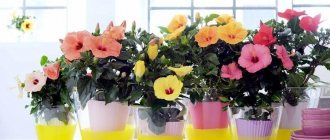Many indoor plants are considered amulets of family happiness, and not the least in this list are campanulas, house bells, aka the bride and groom .
Absolutely identical bushes have different names due to their color. And the name speaks for itself; they are given to families to strengthen relationships, often even for a wedding or anniversary.
Types and varieties with photos
Campanula lends itself well to selection, so today, as a result of numerous experiments, many varieties of inflorescences have been bred: double or with wavy edges, with fringed edges, large-leaved and small .
Blueberry, birdbird, bell, chebotok, Star of Bethlehem - these are the nicknames given to campanula by the people.
Below are descriptions and photos of Campanula varieties suitable for propagation and care at home.
Equal leaf or Isophylla
The species diversity of Campanula is great - more than 400 species - but it is the equal-leaved Campanula (Campanula isophylla) that is grown at home more often than others. The shape is ampelous and does not exceed 30 cm in height. Since numerous flowers weigh down the stems, you should choose a hanging pot of a suitable size. Flowering period is spring and summer. The photo below shows Campanula Equalifolia:
Terry
Campanula terry is a tiny bush (no more than 15 cm in height), strewn with numerous flowers of all shades of blue and white. Appeared by crossing the spoon-leaved and Carpathian species. Petals in the form of stars are collected in graceful inflorescences growing at the ends of the shoots . The color palette is varied: all shades of white, blue, lilac and dark blue. The leaves are bright, juicy, have jagged edges, have a rounded heart-shaped shape and long petioles. The stems are flexible, creating a kind of “cushion” 20 cm or more in height.
You can see what the Campanula Terry variety looks like at home in the photo below:
And this is the Terry campanula in the open ground:
Bicolor
- Berlin Bicolor is a spectacular variety whose flowers are distinguished by unusual colors: the edges of the petals are lavender-blue, and the center is boiling white.
- Old Bicolor Star (Starina Bicolor Star) - looks similar to Berlin Bicolor, but the petals are colored not lavender, but blue.
- Dublin Bicolor is a new variety developed just a few years ago. Rarely found on sale, even in specialized stores. The flowers are star-shaped, the center is white, the corolla is blue.
The photo below shows a flower of the Campanula Bicolor variety:
Care
Indoor campanula flower: subtleties of care at home.
After the purchase
The first thing you need to do is check for new shoots without buds, the absence of dry leaves and pests. Carry out this check not after, but before the purchase, by carefully inspecting the plant in the store.
If you bring campanula home and place it in the chosen place, then within a week you will watch it dry out. Therefore, be sure to transplant the plant into a new pot, and not just by moving the bush, but by removing all the old soil in which it grew. I keep the campanula in quarantine for the first week , i.e. do not place it in a common corner with plants, but put it in another room, in partial shade. Observe: will pests appear on the leaves during this period, will larvae crawl out to the surface of the soil?
Pot
Campanula can be grown in flowerpots, tall flowerpots, or regular pots. Perhaps, it is the stems hanging down that emphasize the beauty of the campanula, so choose a flower pot if possible.
The first pot should not be too deep and wide, but on the contrary – too cramped. Let the roots of the campanula weave more closely into the earthen ball. But choose subsequent containers 1-2 centimeters wider than the previous ones.
Both plastic and ceramic pots have both advantages and disadvantages .
Plastic ones last much longer, rarely break, and the variety of colors allows you to choose a container to suit any interior, which is often of considerable importance for the gardener.
However, the big “minus” of plastic is that it overheats. And this can have a very negative effect on the root system.
Clay pots do not overheat in the sun and allow air to pass through well (except for those covered with glaze). However, moisture quickly evaporates from them, and they break easily. Do not buy polystyrene pots - they are very unstable and will begin to tip over as soon as the campanula grows a little. Choose a flowerpot in the form of a hanging basket.
Priming
Buy a substrate for flowering indoor plants: it is loose and allows oxygen to pass well to the roots. You can make it yourself . Mix leaf and peat soil and coarse sand in equal parts. Don't forget to add expanded clay, small pebbles or broken bricks for drainage.
All components, like the store-bought substrate, must be treated against pests. Even if you are sure that they are not there, this will not harm either the campanula or the soil, and will add peace of mind. You can calcine the soil in the oven for half an hour, freeze it for two days in the freezer, treat it with a weak solution of potassium permanganate or biological fungicides (“Planzir”, “Zaslon”, “Fitop”, “Integral”, “Agat”, “Fitosporin”, “ Barrier").
Lighting
Campanula is a light-loving plant, but direct rays of the sun are contraindicated for it.
By placing the plant on or near the western and eastern windows, you can't go wrong . In the south it will be too hot, in the north there will not be enough light.
If there are no other options except the last ones, organize artificial lighting using a fluorescent or phytolamp, hang thick curtains or put up a paper screen.
On warm spring days and summer, take the campanula to an open balcony or garden - such a walk will benefit the plant. At the end of September, with the arrival of autumn coolness, such trips stop.
An amazing observation: campanula flowers always turn towards the sunlight. However, you should not sharply turn the pot towards the light: this will have a bad effect on flowering. Do this a little bit every day.
Temperature
Suitable temperature for bells: in summer - +22-25 degrees, in winter + 15 degrees. Withstands small temperature fluctuations.
Campanula is not afraid of a small warm breeze , but it cannot stand cold drafts. If you choose a window sill for wintering your pet, check that there are no gaps in the frames. When ventilating the room, take the indoor plant to another room.
Humidity and watering
Campanula loves water, so don’t skimp on moisture. In summer, water the plant every day (on hot days - twice a day) - don’t be afraid, you won’t flood it. In winter, reduce watering, allowing the top layer to dry thoroughly. In spring and autumn, bluebells can easily withstand a slight drought of 1-2 weeks.
Pre-settle tap water by pouring it into a pan and leaving it for a day without a lid. This will remove chlorine, excess salts and other harmful impurities from the liquid. You can use a household filter for cleaning.
Campanula needs high air humidity , so spray it with warm water often and wipe the leaves with a damp cloth. By doing this you will not only clean the plant from dust, but also allow the leaves to “breathe”.
How to replant?
The root system of Campanula is powerful and grows so quickly that it occupies the entire pot in a short time. Therefore, transplants should be carried out every spring. Choose larger containers: for a small-looking plant - 3 or even 5 liters. Planned transplantation, the same as after purchase - by transshipment method. Don't forget about the drainage layer! After the procedure, the soil is compacted with hands and watered abundantly.
Some are afraid to plant the “groom” and “bride” side by side, believing that they may cross-pollinate. Nothing bad will happen, and they will look much more impressive together.
Useful video about transplantation
Top dressing
It is necessary to feed Campanula during the period of active growth. Do this once every 10 days with complex mineral fertilizer. There is no need to do this during the rest period.
Bush formation
If you want to admire the cap bloom , start forming a bush.
Trim all dried stems and flowers, side shoots and top leaves, and bare tips of shoots, making them approximately the same length. The shoots growing from the axils will be of the same age and will begin to bloom “caps”.
Pruning and care after flowering
Hygienic pruning of campanula after flowering is not necessary, but desirable. It is carried out in the same way as the formation of a bush, not only in spring, but also in autumn.
Rest period
The dormant period lasts from October to December . At this time, you should reduce watering as much as possible (to eliminate the risk of stagnation of water in the pot), lower the temperature in the room, carry out additional lighting every day and do a little pruning (leaving shoots 10 cm long with a couple of buds). If before this you properly cared for the plant, by the New Year holidays the campanula will delight you with repeated flowering.
How to care during dormancy
Like any plant, after the flowering period, campanula enters a period of rest, when the plant rests and gains strength before flowering again.
With the onset of late autumn, when the flower completely stops growing shoots and flowering, all shoots are pruned, leaving only 10-12 cm. In addition, it is advisable to move the plant to a cooler place, but well lit, and reduce watering to twice a day. month. Instead of watering, you can also loosen the soil only if the soil is not dry. It is best not to water the campanula, but only to moisten the soil, since damp soil, and even cold soil, can cause the death of the plant.
In general, winter is a difficult period for the plant and it does not tolerate it well. Long shoots must be pruned. The cut area must be sprinkled with crushed charcoal.
Reproduction
Planting by seeds
- Seeds should be planted in the ground in the spring. Pre-soak them in a weak solution of potassium permanganate or “Kornevin”.
- Pour the soil into a plastic cup, moisten it, pour dry soil on top, sow the seeds and sprinkle with water. Cover with film and place in a warm, well-lit place.
- When 3-4 leaves appear, transplant into flowerpots.
Dividing the bush
The most reliable and easiest way to propagate a plant. In the spring, when the campanula begins to actively grow, remove the bush from the pot, carefully cut the earthen lump in half and plant the halves in different pots. The rest of the care is as usual.
Reproduction by cuttings
- Use a sharp, disinfected blade to cut off shoots with a few healthy leaves.
- Place them in a weak solution of potassium permanganate for 10-12 hours.
- When the roots appear, transfer them to a container with clean water for a couple of hours, and then plant them in a container with a substrate (a mixture of peat and river sand). Depth - no more than 3 cm. Cover the container with cling film, creating a greenhouse effect, spray and ventilate the seedlings daily.
- As soon as the root system becomes strong, plant the cuttings in permanent pots.
Transfer
At the end of summer, the growing season of the plant stops, and it requires preparation to enter a state of dormancy. The most acceptable method of propagation is vegetative : by cuttings, green shoots, by dividing the bush into several parts.
Plants need to be replanted more often. Most ornamental plants like to be replanted fairly frequently.
Repotting indoor plants
The fact is that when grown for a long time, no matter how beautiful the plant is, it loses its decorative effect over time, the shoots lengthen, and the distance between the leaves increases. It no longer looks so chic and fluffy, as if it is “balding”.
To avoid this, take cuttings and form new bushes from the resulting cuttings. After a long flowering at the end of summer, Campanella sheds its leaves, the shoots become elongated, and the decorative effect decreases.
Pests and diseases
- What to do if Campanula dries out? If the leaves of your flower dry out, turn yellow or lose their brightness, move it to another place. Most likely, the plant is receiving too much light.
- If the stems become thin and quickly grow in length, on the contrary, there is not enough light. Turn on the phytolamp for 5-6 hours a day.
- Limp, soft-to-touch foliage indicates overwatering.
- Gray rot is determined by the appearance of gray spots and black dots on the leaves of Campanula. Cut off the damaged parts, treat the cut areas with crushed activated carbon, and soak the root system in a solution of potassium permanganate (pale pink) or fungicide for half an hour. The same procedure applies to root rot.
Spider mites and scale insects often attack campanula, so keep insecticides in stock : Aktara, Metaphos, Fitoverm, Permethrin. But first: wash the plant in the shower (covering the pot with plastic so that the soil does not become sour). Afterwards, place the flower in a plastic bag, sprinkle the inside with the preparation and, after tying, leave for half an hour. After which the plant is washed again. The procedure should be repeated after a week.
If the pests have not yet invaded your flower, try using a folk remedy. For example, mix 15 ml of soap shavings, 10 ml of alcohol and 1 liter of boiling water, beat the mixture until foamy and treat the plant.
Description
Bridal bush grows best in warm climates. That is, on the territory of our country, for the most part, southern regions are suitable for its cultivation. Even in the middle zone, the plant is not very common due to its heat-loving nature. But starting around Tambov and further south, gardeners cultivate spurge with great pleasure.
Euphorbia is famous for its rapid growth: from the moment of planting to the appearance of a lush, bushy plant, only a few months pass. Euphorbia looks gorgeous in the garden, representing a real decoration of the surrounding landscape.
Since the plant easily reproduces in favorable conditions by self-sowing, it is able to “occupy” all nearby free territories in a short time. If you are not too happy with this garden design option, you will have to remove the seed pods on time.
Signs and superstitions
It is believed that you should buy campanula for growing in the house in pairs, planting both the “groom” and the “bride” in the same pot so that they generate positive energy for the home.
Gentle bells know how to absorb other people's negative influence , prevent quarrels and help cope with stressful situations. The bride and groom give harmony to the home and have a calming effect on the nervous system.
It is recommended to give campanula to newlyweds as a wedding gift, and couples who want to have a child should put a pot with the plant in the bedroom. If you take good care of the plant, and it suddenly dies, it means that your campanula has received damage aimed at you. Thank the flower for its help and bury it in nature.
Photo gallery
cvetok_52
cvetok_52
tsitsilinaelena
parkhouse_05
olga.kopacheva
olga.kopacheva











